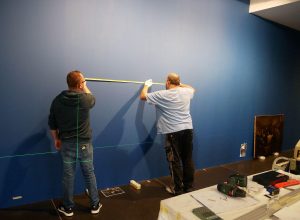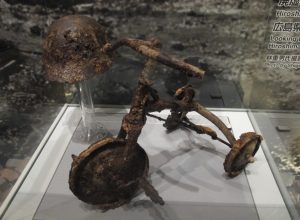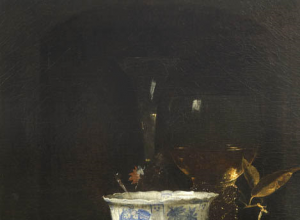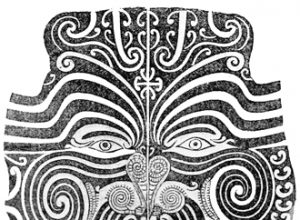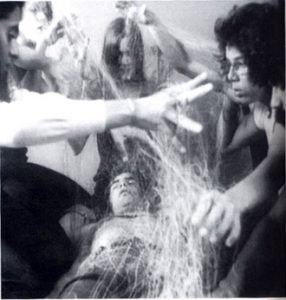
Christian Joschke invited us, during this seminar, to make the connection between avant-garde movements, on the one hand, and the practice of gift-giving and the social sciences’ take on the circulation of goods and assets, on the other. In doing so, he pointed out a peculiar development. In the 1930s, and again in the 1960s, the ritualized form of ostentatious gift-giving adopted by avant-garde movements was used to attack society’s established commercial order, whereas in the 1990s the avant-garde was reduced to extolling the social bonds art establishes. That is because the status of gift-giving had appreciably changed in the intervening years: gift-giving went from being a form of violence directed against this commercial order to being a positive gesture in its own right, as the social sciences evolved from holding a view radically opposed to commercial exchanges to representing gift-giving as an act that nevertheless fits neatly within commercial as well as noncommercial relations (relations that structure and renew relationships based on mutual trust among social agents). Studying the problematic of gift-giving in contemporary art as a form that is openly critical of commodities, Fabien Danesi distinguishes for us some of the variants of gift-giving while agreeing with Joschke’s analysis, which had identified a historical development that has gone from violent opposition–be that violence only symbolic–to social compromise–be it a compromise that is accepted only with a heavy heart.
Laurence Bertrand Dorléac
Seminar of January 22th 2009
Mass for Marcel Mauss:
Gifts, Exchanges and Potlatch in Contemporary Art
Fabien Danesi
In its generally accepted meaning, the word gift refers to the principle of ceding possession of some good in a way that implies freeness or gratuitousness [la gratuité]. In this respect, it is tied to disinterestedness, a notion that has been central to artistic creativity and beauty since the time of Kantian aesthetics. For the anthropologist Alain Caillé, however, gift giving can be defined, above all, as “any provision of goods and services carried out, without guarantee of reciprocation and with a view toward creating, maintaining, or regenerating a social bond.”[ref]Alain Caillé, Anthropologie du don. Le tiers paradigme (Paris: La Découverte, 2007 [2000]), p. 124. [/ref] Now, this emphasis on the value of social ties (to the detriment of the gift-object that makes them possible) has been and remains one of the characteristic features of participatory art. We may thus ask ourselves to what extent gift giving has become one of the artistic procedures to which artists have appealed, and particularly so when they have an eye toward finding alternatives to the primacy of economic value and to fetishization. And yet, is not gift giving–as an act lacking in all reciprocity–not “the very figure of the impossible,”[ref]Jacques Derrida, Given Time: I. Counterfeit Money, trans. Peggy Kamuf (Chicago: University of Chicago Press, 1992), p. 7.[/ref] as Jacques Derrida has underscored in his effort to deconstruct the ideal of humanism?
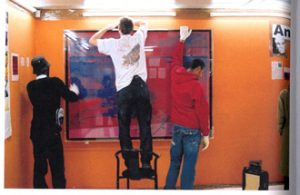
Thomas Hirschhorn, Mounting of the Andy Warhol exhibition (May 31, 2004).
This question can be raised with regard to the Musée Précaire Alibinet (Albinet precarious museum) created by Thomas Hirschhorn in the Landy neighborhood outside Paris in partnership with the Laboratoires d’Aubervilliers. Each week for a period of two months, a work taken from the collections of the French National Museum of Modern Art was presented in a makeshift space built for the occasion with the help of the local housing project’s residents, so that they might be given access to a culture that is often alien to them. The newspaper Le Parisien thus offered “Dali, c’est gratuit” (Dali for free) as the title for an article about this noble attempt at sharing, which Yvane Chapuis designated as “the love of art.”[ref]Yvane Chapuis, “Avant-propos,” Musée Précaire Albinet, Quartier du Landy, Aubervilliers (Paris and Aubervilliers: Éditions Xavier Barras/Les Laboratoires d’Aubervilliers, 2005), no pagination.[/ref] Consequently, this altruistic undertaking, aimed at everyone gaining access to aesthetic creations, affirmed its universal character without ever questioning it and left aside the fine business of cultural communication this piece represented for the institutions involved.
Despite the “violence of transgression” [ref]Thomas Hirschhorn, “À propos du Musée Précaire Albinet, à propos d’un travail d’artiste dans l’espace public et à propos du rôle de l’artiste dans la vie publique,” Le Journal des Laboratoires, 2 (June 2004). Reprinted in ibid.[/ref] evoked by Hirschhorn, his project seems to be situated more on the side of reconciliation, in the tradition of the relational aesthetics articulated by the art critic Nicolas Bourriaud. In 1998, the latter brought together, under this heading, various “interactive, user-friendly, and relational”[ref]Nicolas Bourriaud, Esthétique relationnelle (Dijon: Les Presses du réel, 2002), p. 8.[/ref] artistic practices that belong to the “interstices of society.” He thus underscored that “this term interstices was used by Karl Marx to describe trading communities that were outside the framework of the capitalist economy, because they were shielded from the law of profit: bartering, sales at a loss, autarchic forms of production, etc.”[ref]Ibid., p. 16.[/ref] While gift giving is not mentioned here, it could be added to this nonexhaustive list of alternative practices that make an end run around the market.
This is the case with Rirkrit Tiravanija, who often places cooking utensils at the disposal of the public so that they might prepare a meal and thus transform his installations into sites for sharing. A sophisticated piece, like Dom-Ino, presented in the Chantal Crousel Gallery in 1998, borrowed from Le Corbusier’s 1914-1915 prefabricated frame and turned out a version in wood. The three platform floors harbor a kitchen and a living-room suite, then mattresses, and finally a sort of rooftop terrace. The viewer is invited to enter the structure. But does such an invitation amount to giving the work use value, as against exchange value and the abstraction thereof, in the tradition of Marxist theories? And in this case, does not the creativity here attenuate the idea that gifts contain, in themselves, a critique of “instrumental interest,” as Caillé mentions?[ref]Alain Caillé, Anthropologie du don, p. 127.[/ref]
An indirect answer may be offered by looking at the practices of Didier Courbot. Courbot’s interventions in the public space occur in the form of modest but generous gestures, like repainting a pedestrian crosswalk or repairing a bench. His Needs series (1999-2001) captures in color photography the uncompensated actions he has performed to meet small needs–an indication that his performances have at once a utilitarian and a symbolic dimension.
These two schemes are, moreover, not so distinct, if we are to believe Pierre Bourdieu. The French sociologist explains that the economy of symbolic goods (which is thought of in opposition to interest and calculation) is an illusio: it is a “collective self-deception” inasmuch as “at the basis of generous action, of the (apparent) inaugural gift in a series of exchanges, there is not the conscious intention (whether calculating or not) of an isolated individual but that disposition of habitus which is generosity, and which tends, without explicit and express intention, toward the conservation and increase of symbolic capital.”[ref]Pierre Bourdieu, Pascalian Meditations, trans. Richard Nice (Stanford, CA: Stanford University Press and Cambridge, UK: Polity, 2000), p. 193. [/ref] According to Bourdieu, charity or any other kind of devotional activity ends up concealing relations of force and, with them, a form of negativity.
Such negativity is to be found again, however, in certain emblematic practices of relational aesthetics, such as those of Félix Gonzalez-Torres. His piles of candy, offered to people with sweet tooths, carry a heavy load when they match the weight of his AIDS-infected companion (Portrait of Ross in L.A., 1991): the gradual disappearance of such sweet pleasures becomes here the metaphor for the impending loss of his own beloved. This tension between bitter personal experience and the casual attitude of visitors testifies to an ambivalence of gifts not taken into consideration in the reflections of Bourriaud.
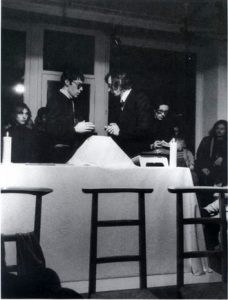
Michel Journiac, Messe pour un corps, (Mass for a body, 1969).
A similar sort of violence, moreover, was expressed in a much more strident way in the performances of some 1960s artists, such as the Messe pour un corps (Mass for a body) Michel Journiac organized on November 26, 1969 at the Daniel Templon Gallery in a co-production with the Martin Malburet Gallery. In celebrating the Eucharist with slices of a sausage made from his own blood, the artist effected a sacrilegious substitution evocative of the death of God and of the indomitability of the body, “an absolute that desire and death reveal.” [ref]Quoted by François Pluchart, “Entretien avec Michel Journiac,” ArTitudes International, 8/9 (July-September 1972): 28. Reprinted by Julia Hountou as “De la carnation à l’incarnation,” in Michel Journiac (Strasbourg/Paris: Éditions des Musées de Strasbourg/Éditions ENSBA, 2004), p. 83.[/ref]. In this ritual form, the détournement of the Christ-like gesture took an eminently tragic turn.

Lygia Clark, Anthropophagical Dribble (1973).
This sacrificial form of sharing is to be found again in the collective events Lygia Clark organized as part of her art courses at the Sorbonne University in 1973. For her Anthropophagical Dribble, students held in their mouths colored spools they were asked to unwind slowly in order to cover the body of one of the participants, who was laying down on the ground. The gradual unfolding of the performance led to everyone becoming entangled together with this “dribble.” Another action performed the same year, Cannibalism, suggested that a student wear a suit with a stomach-level pouch filled with fruit. Blindfolded, all the people placed around him were to take a bite from the food then let it go and pick it up again.
With these two experiments, Lygia Clark was suggesting that giving and taking were not antinomic. “I am one huge mouth that swallows, devours, and grinds up everything,” she wrote. “I am a small body; I want to occupy the whole space of the world. . . . I give everything to the other, expecting in return his impressions after he has tried out all my offerings.”[ref]Lygia Clark, “L’homme, structure vivante d’une architecture biologique et circulaire,” Robho, 5/6 (Paris, 1971). Reprinted in Lygia Clark, p. 291.[/ref] From this perspective, what becomes apparent is “perseverance in its being,” which Spinoza named in his time the conatus. Taking up again this philosophical postulate, Frédéric Lordon states that “to exist is to be self-interested. An action has no other meaning than to be accomplished in the first person–that is to say, whatever its nature, and in particular when it takes the most oblatory forms, it is accomplished by an agent who, in committing therein his existential activity and acting through his own movement, necessarily acts relative to himself, that is to say, in the end for himself.”[ref]Frédéric Lordon, L’intérêt souverain. Essai d’anthropologie économique spinoziste (Paris: La Découverte, 2006), p. 34.[/ref] Confronted with this conatus, the potlatch–giving, receiving, reciprocating–would have been the first attempt at the social level to repress the drive to seize and to hoard.
Potlatch was as a matter of fact the name the Lettrist International chose in 1954 for the title of its Bulletin d’information. The group was of course making reference there to a practice that had developed on America’s Pacific Northwest Coast, and which Marcel Mauss had studied in the context of his much talked-about 1923-1924 “essay on gifts.” There, the ethnologist described the triad of the potlatch’s components as a system of “total services of an agonistic type”[ref]Marcel Mauss, The Gift: The Form and Reason for Exchange in Archaic Societies, trans. W. D. Halls, 2nd rev. ed. (London and New York: Routledge, 2002), p. 8. [/ref] with economic, legal, religious, and ultimately mythical dimensions. Now, the level at which the group led by Guy Debord wished to act was very much the global one: “the obligation to reciprocate constitutes the essence of the potlatch,”[ref]Ibid., p. 53.[/ref] Mauss had written, and in the situation of the time this obligation consisted in a complete overthrow of society. The revolution was the most beautiful of all possible ways of spending. It extended, in a concrete way, “the Copernican revolution”[ref]Georges Bataille, “La part maudite (1949),” Oeuvres complètes, vol. VII (Paris: Gallimard, 1976), p. 33F.[/ref] Georges Bataille had initiated with his essay on “general economy”[ref]Ibid.[/ref] where the glorious conduct of the potlatch was presented as a tremendous counterexample to modern economics, which is based on commodity production.
In our time, the radicality of these first moments may seem remote. And with regard to this (too brief) evocation, it may be pointed out that in contemporary art gift giving has undergone changes that overlap in certain respects with the gradual abandonment of the desire to create a new community and favors, instead, a compartmentalized approach, one conscious of the rules of the game of specialization. Thenceforth, the potlatch, as a phenomenon of “social morphology”[ref]Marcel Mauss, The Gift, p. 137.[/ref] seems but a fading memory of an outdated outlook wherein the sovereign power used to take on the outward appearance of self-abandonment to the collectivity. Yet it remains the case that one of the foundations of gift giving, wherein “it follows that to make a gift of something to someone is to make a present of some part of oneself,”[ref]Ibid., p. 16.[/ref] survives implicitly through royalties and authorial rights [le droit d’auteur], as opposed to copyright. A similar metamorphosis of gift giving into artistic creation thus serves as a reminder of what Derrida had noted in the form of an aporia: “At the limit, the gift as gift ought not appear as gift: either to the donee or to the donor.”[ref]Jacques Derrida, Given Time, p. 14. [/ref]
Bibliography
Bataille, Georges. “La part maudite” (1949), Oeuvres complètes. Vol. VII. Paris: Gallimard, 1976.
Bourdieu, Pierre. Pascalian Meditations (1997). Trans. Richard Nice. Stanford, CA: Stanford University Press and Cambridge, UK: Polity, 2000.
Bourriaud, Nicolas. Esthétique relationnelle. Dijon: Les presses du réel, 1998.
Caillé, Alain. Anthropologie du don. Le tiers paradigme (2000). Paris: La Découverte, 2007.
Derrida, Jacques. Given Time: I. Counterfeit Money (1991). Trans. Peggy Kamuf. Chicago: University of Chicago Press, 1992.
Hirschhorn, Thomas. Musée Précaire Albinet, Quartier du Landy, Aubervilliers. Paris and Aubervilliers: Editions Xavier Barras/Les Laboratoires d’Aubervilliers, 2005.
Lordon, Frédéric. L’Intérêt souverain. Essai d’anthropologie économique spinoziste. Paris: La Découverte, 2006.
Lygia Clark. Barcelona, Paris, Marseille, Pato, and Brussels: Fundacio Antoni Tapies, Réunion des Musées Nationaux, Galeries Contemporaines des Musées de Marseille/Fundaçao de Serralves/Société des Expositions du Palais des Beaux-Arts, 1998.
Mauss, Marcel. The Gift: The Form and Reason for Exchange in Archaic Societies (1923-1924). Trans. W. D. Halls. 2nd rev. ed. London and New York: Routledge, 2002.
Michel Journiac. Strasbourg and Paris: Éditions des musées de Strasbourg/Éditions ENSBA, 2004.
Spector, Nancy. Félix Gonzalez-Torres. Paris: ARC Musée d’art moderne de la ville de Paris, 1996.
Fabien Danesi is an associate professor who teaches the theory and practice of photography at the University of Picardy–Jules Verne. Now with a doctorate in art history, he worked, while writing his dissertation at the University of Paris-I, on the postmodern progeny of Marcel Duchamp’s readymades. A former pensioner at the French Academy in Rome (Villa Médicis), he is the author of Le mythe brisé de l’Internationale situationniste. L’aventure d’une avant-garde au coeur de la culture de masse (1945-2008) (Dijon: Les Presses du réel, 2008) and is currently preparing a book entitled Le cinéma de Guy Debord ou la négativité à l’oeuvre (1952-1994) (forthcoming from Paris expérimental).
